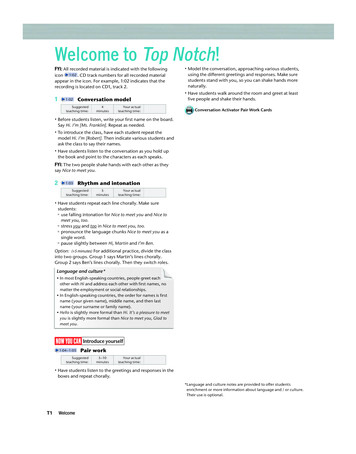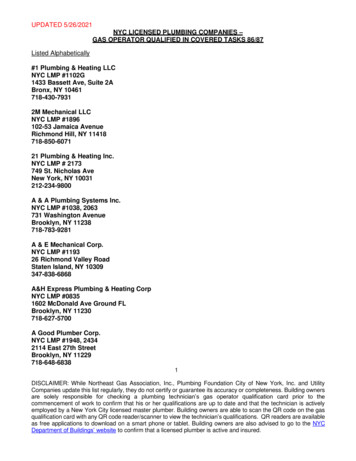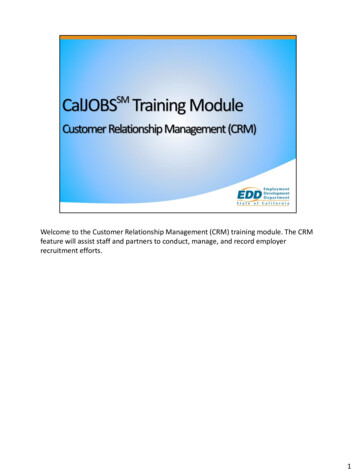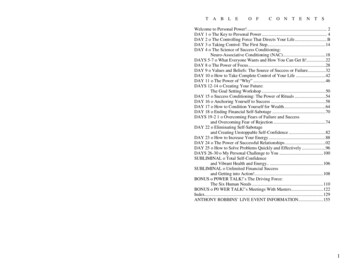![Welcome [ Coachingwithnlp.co]](/img/15/free-nlp-coaching-course-manual-smaller.jpg)
Transcription
WelcomeWelcome to this to this Free NLP Coaching course. The course has been designed to give you anintroduction to NLP and some of the techniques that are taught during the live training. The aim of thetraining is twofold. Firstly to give you some tools to create and achieve more of the results you want in life. Secondly, to assist you in deciding if taking the live training with Coaching with NLP is the rightdecision for you.You will be able to watch this training as a set of videos, or be able to download the audios, so that you canlisten to them at a time and place that suits you. You can access all these files seNLP and Coaching is and can be a very rewarding profession, both financially and even more importantly,emotionally. To assist your client in achieving their goals, regardless of context, gives one a sense ofaccomplishment and it is an honour to be involved in another’s journey. Not only do you get the opportunityto have a positive impact on somebody else’s journey, but you can create massive positive change in yourown life.During the full live training you will learn many additional techniques to work with people from all walksof life, as well as personally dealing with things that may have held you back in the past. The focus is onmoving forward and yet we know that in order to move forward, we may sometimes need to let go of somethings in our past. That is where techniques taught in Time Line Therapy is especially useful. Let go oflimiting decisions, limiting beliefs, anxiety, phobias, fears and other negative emotions. This will help youto stop simply being a passenger. Be in charge of your life and create the life that you want and deserve.My name is Wayne Farrell, owner of Coaching with NLP and an internationaltrainer of NLP, Coaching, Hypnosis, Time Line Therapy , Speed Reading andother personal development courses. I am passionate about personal developmentand helping you to achieve your fullest potential.I welcome you with open arms and will guide you through this training. Shouldyou have any questions, please feel free to contact me directly on the detailsbelow.All of us at Coaching with NLP, are committed to do everything we can tomake sure that your learning is the best that it possibly can be. IN South Africa: Call on 27 (0) 7491 57633, or e-mail: wayne@coachingwithnlp.coIN U.K and Europe: Call us on 44 (0) 7947 099280, or e-mail us at:wayne@coachingwithnlp.coDedicated to your success.Wayne Farrell1 Coaching with NLP- Introduction to NLP- 2016
CONTENTSWelcome . .1Contents . .2Definition of NLP . . .3What is NLP useful for .4Cause and Effect . .5NLP Communication Model . 7Perception is Projection .8Neuro Transmitters . 10Responsibilty fo Value and Change .11Grey Zone .12The Presuppositions Of NLP 13Unconscious Mind . . .14Sensory Acuity . . . .16Rapport . . .17Perceptial positions . .18Five Principles For Success .19Wheel of Life .21Description of each area 22Questions you could ask .23Writing your goal .24Time Management . .27Be Free from Anxiety . .28Choosing a NLP Provider .29Congratulations .30Topics Covered in Live training .312 Coaching with NLP- Introduction to NLP- 2016
DEFINITION OF NLPThe study of the nervous system and the mind (howwe think,) through which our experience is processedvia five senses:Neuro: The study of language and other nonverbalcommunication systems through which our neuralrepresentations are coded, ordered and givenmeaning. Includes:Linguistic: atoryPicturesSoundsFeelingsTastesSmellsWords (Self Talk)The ability to discover and utilize the programs thatwe run (our communication to ourselves and others)in our neurological systems to achieve our specificand desired outcomes. (So the sequence of ouractions and how we motivate ourselves.)In other words, NLP is how to use the language of the mind to consistently achieve ourspecific and desired outcomes.NLP is really the study excellence; discovering excellence and then being able toutilise it in such a way that we can create change in ourselves and others. It beginsfrom the attitude of curiosity and a willingness to experiment. We have this curiosityand willingness for experimentation, and we create these results through modellingthis excellence of people who are most excellent in their fields.3 Coaching with NLP- Introduction to NLP- 2016
WHAT IS NLP USEFUL FOR?NLP is useful in all areas of our lives. From business to therapy to education to our own personallives. Helping to empower ourselves and others we interact with.The NLP communication model helps us to understand how we create internal representations. Howwe hold that internal representation in our head makes a difference in terms of how we produce ourstate, our physiology and thus our behaviour. Which in turn impacts on your performance.Keys to an achievable outcome and well formedness conditions help to know your outcome, having agoal and knowing where you want to go.Being able to build rapport with others is an invaluable skill in therapy, business and education togain results. Being able to create a feeling of trust is conducive to effective communication.Understanding the other persons preferred representational system is very useful, knowing whichpredicates to use to assist the other person to “get” what you mean. You heard people say, “I don’tsee what you mean?” or “I don’t get a feel for it?” They are telling you exactly what you need to doto explain in a different way, but mostly we don’t realise it.Understanding how we can say the exact same thing with different intonation patterns, which canactually mean different things to the listener. So being able to get the right message across whenspeaking to others.Understanding eye patterns and what people are doing when they move their eyes in differentdirections. How do they access information?Submodalities are very successful in creating very quick change and results to help yourself andothers with things like minor negative states or behaviours. Maybe getting to like something (likevegetables) which they don’t and they need to for their health. Stop eating something that they reallywish they could stop eating. Help with changing limiting beliefs etc.Hierarchy of ideas helping to make communication more abstract or more specific. Help withproblem solving. Helps in negotiation and arbitration.The Meta model is very useful to help get very specific with what a person means when they saysomething. Have you ever had somebody not do what you asked them to do, yet they felt that theydid it as you asked?Metaphors are very useful in helping people to get the results they want without telling them directlywhat they need to do. Story telling is very powerful in getting results. Especially with children.Anchoring to change and control your state, e.g. being motivated, happy, confident etc. Easily get ridof procrastination.Understanding the strategies that people use. Example how to make decisions, whether they serve usor not. Understanding strategies means we can change them easily to create the results we want.Another example is helping somebody who has a shopping problem and is a compulsive buyer.Parts integration is useful to get rid of incongruence or internal conflict. You’ve heard people say,“on the one hand I want to do this and on the other hand I want to do that?”Time Line Therapy is phenominal in letting go of negative emotions and limiting decisions, phobia,PTSD, limiting beliefs that hold you back etc. Easily get rid of anger, fear, sadness, guilt etc.These are just some of the techniques you will learn during the live training and things that NLP canhelp with. People are getting phenominal results using the skills in different settings and areas of life,whether they are teachers, parents, business people, sales people, psychiatrists, doctors, coaches or inwhichever capacity they work with others. The techniques taught in NLP have far reaching benefitsand mastering them can have a massive positive impact on your life.4 Coaching with NLP- Introduction to NLP- 2016
CAUSE AND EFFECTC EWhich side of the equation are you on?Are you at cause for everything in your life, or are you at the effect of things happening too you?Twenty years from now you will be more disappointed by the things you didn’t do than by the onesyou did do. So throw off the bowlines. Sail away from the safe harbour. Catch the trade winds inyour sails. Explore. Dream. – Mark TwainNo matter where we are in our lives or careers, we either have the results we want, or we havereasons as to why we have not yet achieved what we want.The fact is that most people will give you reasons for notyet having achieved what they want. Reasons why theyhave not been on that holiday in 5 years, whether it is a badeconomy, being laid off, illness or whatever is going on intheir life. There are reasons that they are not satisfied inthat area of their being and reasons for things not being theway they want them to be.Now imagine if you knew the day you were going to moveon from this life. Imagine lying down 5 minutes before it was time to pass on and you think toyourself, “I would have,” “I could have” or “I should have.” How many people do you know haveuttered those words or something along those lines? “I could have been a contender, but that thinghappened to me and it ruined everything.” These are reasons for not having had it all.(Now very importantly, I want to be very clear at this point and say that this does not mean theperson is to blame or at fault. Please bear this in mind. The idea of finding the reasons is not to saythat you or your client is at fault or to blame. It is not about beating yourself up.)Now as we imagine that moment before passing on and think about the things we had not achievedand the reasons for not doing so, I am sure you can agree that would not be very satisfying. It wouldnot be liberating to think and certainly not empowering. In fact, you could almost imagine feelingcheated. I appreciate that there is no evidence that you are always totally responsible for whathappens to you all of the time. There is no evidence to say that we CAUSE everything in our lives.5 Coaching with NLP- Introduction to NLP- 2016
I do however suggest that in many cases, having a very good plan and implementing the plan bytaking the right actions, that results can be achieved.Furthermore, any feedback and learnings we get from not achieving the intended goal, serves toempower us and help us to hone the action plan into one that may lead us to success. Thomas Edisonfamously replied that he did not fail 10,000 times, but rather found 10,000 ways not to do it, when hewas asked about all the previous failures in creating the light bulb.In many cases people will actually blame everything and everybody around them as to why they havenot succeeded. Many people are professional victims and love to play the victim or blame game.Having these reasons for not having achieved the goal is not all bad though. It is merely a matter ofperception. Once we understand what the reasons are, we can change our focus and create a properaction plan to achieve the results we desire. This can be achieved by coaching and helping the clientto overcome or navigate the stumbling blocks on the path to success.Destiny is not a matter of chance. It is a matter of choice. It is not something to be waited for, Butrather something to be achieved.– William Jennings BryanNow let’s focus on the “CAUSE” side of the dichotomy. Let’s pretend we were at the cause forwherever we are in our life. You may argue and say something like “I did not ask to be in a caraccident,” or “I did not ask to be shot,” or whatever bad thing could have happened in our lives. Ionly ask that we IMAGINE that we were at cause for everything that has happened and where wemay be in our lives. That the rest are merely reasons and now we want to focus on the result.The fact is that we are where we are based on our conscious and unconscious decisions that have ledup to that point. Here is an example. Let’s imagine a client has been involved in a bank robbery andthey were held up at armed gun point. So now they suffer with PTSD. I know that sounds a littleextreme and I can assure you that there are many worse things that have happened to clients.The fact is that the client was at that particular bank atthat particular point of time, based on their consciousand unconscious decisions. Now please remember,we mentioned before that this does not suggest thatthe person is at fault or to blame. It merely points outthat we are where we are, based on our conscious andunconscious decisions. This is one of the fundamentalthings I discuss with my clients and once they acceptthat fact, they are empowered to take the right actionto achieve the results they want.Now we can take the learning from the experience to help us in the future. I realise this may beuncomfortable for some people to accept. Again there is no evidence to suggest that we can alwayscontrol what happens to us. What it does do is to free us up from the blame and victimhoodmentality, to focus on the results we truly want. This is a much more empowering position to be inand is a springboard to achieving the results we want. When something is not working, then we canchange our course of action to assist in moving in the intended direction.“The definition of insanity is doing the same thing over and over and expecting different results.”Albert Einstein.6 Coaching with NLP- Introduction to NLP- 2016
COMMUNICATION MODELAccording to the Hungarian Biologist, Mihaly Csikszentmihalyi, we get bombarded by around 2million bits of information per second through all out in put channels. (Scientists now say it to bemore like 11 million.) He said that we can only process around 134 bits per second. My 134 bits ofinformation is different to yours, because I delete, distort and generalize differently to you based onall my internal filters.Without deletion we would be faced with far too much information for our conscious mind to handle.Deletion occurs when we selectively pay attention to particular aspects of our experiences and notothers. Like driving down the road you don’t look at every single signboard. Similarly have you evernoticed a new building or something you had noticed before and yet it has been there all that time.You simply deleted it as it was not important before.Distortion happens when we make shifts of data in our sensory data, by making misrepresentations ofwhat is real. For example, this can happen when we mistake somebody for someone else or even‘imagining’ how somebody might look before you have even met them.Generalization is like where we draw conclusions about someone or something based upon previousexperiences. To generalize can help us to learn by taking information we have and drawingconclusions about the meaning of the effect of those conclusions. Example if you burnt your hand ona hot plate once, you don’t need to touch another hotplate to know that will also burn. It can cause usto form limiting beliefs about ourselves and our capabilities based on a previous failure, which canthen hold you back from doing it again the rest of your life.7 Coaching with NLP- Introduction to NLP- 2016
PERCEPTION IS PROJECTIONWe can only perceive what is already in our consciousness. This comes from a guy called Carl Jung,who was a Swiss psychologist and one of the 3 fathers of psychology, along with Freud and Adler.He said what we perceive is who we are. What we perceive outside ourselves is who we are. Thatmeans we can’t perceive anything out side of ourselves that is not us.You may say, yes, I can agree he is my projection, or he is, but that person certainly is not. What CarlJung said, “We tend take our most unconscious material and project it on people and events aroundus. That which is unconscious must of need be projected on people and events that are around us.”The reason is that when we encounter that projection, then we can become conscious of it and dealwith it. When we get the learning’s, then that projection will change. This has an impact on results.Your clients will come to you for whatever change they want and a lot of you getting results willdepend on your beliefs and projections inside of you and them.This has been proven with kids. They took a group of kids and told a teacher that the “special needs”teacher was not available that year and they will have to teach them and just do the best they could.The kids all got around a “C” average. The next year they took the same kids and told anotherteacher, that the kids were gifted and the teacher who should take them was not available. So theywould have to teach the kids. That year the kids all got A’s and B’s. So the point of view of theteacher was projected onto the kids and their performance. That is also true about your kids if youhave any and it is also true about yourself. Your unconscious mind will perform to the extent that youbelieve it will perform and to the extent that you believe it will not perform, it won’t.8 Coaching with NLP- Introduction to NLP- 2016
We tend to perceive people and events around us based on our preconceived filters and thosepreconceived filters, Carl Jung called architypes. Which means much of our perception and thereforemuch of our projection are architypes and is influenced by your personal beliefs, personal choicesand your personal decisions.The 25,000 genomes in the human body cannot be responsible for all the variations and differences inpeople. All the differences cannot be accounted for simply by genetics. In 2002 scientists cloned acat. Cat 2 has the same genetic makeup as Cat 1. However it had a different fur color. How is itpossible that with exactly the same genes, Cat 2 had a different fur color than Cat 1?This shows that there is a lot more regarding the environment, what's going on in your mind thatmakes the difference in people. Going back to the 134 bits per second which you choose out from the11 million bits available every second. Imagine if I hand you 134 marbles per second. Now imagine Igave you 11 million marbles at a time. You could not possibly take them all. That’s the amount ofinformation that we miss or leave out of our perception. People cannot be any other way that weproject them to be. What it means is it's impossible for us to perceive something that we are not. Sowhen you look across your spouse and you say, "She looks so magnificent," then that's you. If youlook across your spouse and you say, "She's no good," that's also you. So whatever you perceive insomeone else or something else is your projection.Often when people are in situations where they don't like what's going on, the want to run away andhope that in the new place things will be better. The people would be different, but eventually thesituation will be very similar, because it is the same projection. Until that projection becomesconscious, meaning when you look outside and realize “what I observed outside of me is just me,”things won’t change. The grass is not greener on the other side. When the projection is unconsciouswe think it is someone or something else’s fault that things are the way they are. The thing is torealize pretty much everything is you. This is powerful especially when working with clients. To theextent that you have negative emotions about someone or something else, the more likely it would bea projection of yours.So we need to ask yourself, what is it in me that I need to deal with? That is not to say that we look atexample a murderer and be ok with what they did. It means that we deal with what we are projecting,so that we don’t have a major negative reaction to it. We could say that to the extent that I havenegative emotions about someone I can be sure that it is a projection. To the extent that I havepositive emotions or to the extent that I have no negative emotions, then I can be sure that I haveincorporated that inside of me. Because everything is a projection.9 Coaching with NLP- Introduction to NLP- 2016
NEUROTRANSMITTERSThe neurotransmitters are the little dots you see between the 2 neurons above. As information travelsthrough our bodies, electrical signals travel down one neuron, then as the information (signal) hits thesynaptic gap, it converts to a chemical signal. It is then taken up by the next neuron and is againconverted to an electrical signal. These neurotransmitters can pass information to every cell in ourbody. So our thinking has an impact on our body as the information is passed from cell to cell. Themind body connection. This is very important in what we tell ourselves through our thoughts andbeliefs.When they first discovered neurotransmitters, they thought they were only in the brain. Then theythought they were only between the Neurons, but then they found, they are even in the uptake of thecells in every cell of the body. Scientists found that even after removing the brains of rats (onlyleaving the brainstem) that the rats could still run a maze. (Karl Pribram PhD, postulated theholographic brain in the 1960’s, saying that memory is stored holographical through the body and notjust in the brain.) That proves the “Mind Body Connection.” That is really important. What that saysis the thoughts you hold in your mind, can affect your body. How? Well the thoughts you hold canmove through the Neuro transmitters throughout your body.Have you ever noticed that when you have “stinking thinking,” you get those types of results? Peoplecan think themselves sick. What about people that have healed themselves from illness from whichthey should have died?If you have not yet, then I would recommend reading Deepak Chopra’s book, Quantum Healing. Inthere he talks about the neurotransmitters that bathe every cell in our body. He calls this the mindbody connection and says that our body and immune system is essentially eaves dropping on ourthoughts.10 Coaching with NLP- Introduction to NLP- 2016
RESPONSIBILITY FOR VALUE AND CHANGEIt is interesting how sometimes people go to training and they take the most awesome notes. Theymake colour charts, underline keywords, draw mind maps and create notes that any PhD would beproud of. Then, when they get back home, they take those notes and they put them on the dusty noteshelf. Next to all the other notes they took of courses gone by. Courses where they had everyintention to take some form of action, but it seems life just got in the way and things slipped. On theother hand, the next person who did the same course, actually took those skills they learnt and createdwonderful change in their life.Similarly, 2 people can buy the exact same car. One person can drive their car every single day.Taking it camping, towing the boat and jet skis, going on family holiday etc. While the second persononly drives the car to church and back each Sunday and then parks it in the garage until next Sunday.Five years later, when the day comes to trade the car in, the first person is all too happy to buy thenew version of the vehicle. Whilst our second person does not believe it is worth buying a car of thatprice and size. They found that the car was simply a waste of resources as they got very little usefrom it.Let me ask you a question, “Who’s responsibility was it to get value from the car?” The owner of thecar of course. The car has got the potential to use it either way, but to get what we need from it, weneed to use it. Similarly, somebody who says, I once did that course, but I never did anything with it.Whose responsibility is it to make the most of the new skills they had learnt?This is a very important consideration in creating value and change from anything we do or learn.The product is merely the product. It is what we do with it that is important.When you say that you are going to take certain actions to achieve your goals, then the goal is simplya dream until you physically take the actions to go and achieve it.11 Coaching with NLP- Introduction to NLP- 2016
GREY ZONEQuality of lifeReally GoodReally BadThe grey zone is the area where your life is ok and you are just cruising along. You know the goodparts and the bad parts and you just get on with your life. The grey zone is where most people sittheir entire lives. It is comfortable and they don’t want to change. You ask somebody how they doingand they say, “I’m OK,” or “It’s alright.”People say they want to change, but at the same time they like how things are going and don’t wantto upset the apple cart. "I want to change but I want to stay like this."“For things to change, you have to change.” – Jim RohnHow many people do you know who were affected by the recession? Some sink whilst others thrive.People can easily make changes when things are good. You win the lottery, it is easy to change yourcar, buy a different house, and change your diet, etc.Unfortunately that's not how it always works. Sometimes things happen in your life where it getsreally bad. Like losing your job. Then you change because it hurts. You might have to start thatbusiness you have been talking about for a long time, because you now you have to bring in somemoney to feed the family.Sometimes people try to run away from change because it is uncomfortable. Without change there isno growth, you cannot grow and stay the same at the same time. Growth is not always comfortable.12 Coaching with NLP- Introduction to NLP- 2016
THE PRESUPPOSITIONS OF NLPConvenient AssumptionsRESPECTUR-WORLD1.Respect for the other person’s model ofthe world.2.Behavior and change are to be evaluatedin terms of context, and Ecology3.Resistance in a client is a Sign of a lack of rapport. (There are no resistant clients,only inflexible communicators. Effective communicators accept and utilize allcommunication presented to them.)4.People are not their behaviors. (Accept the person; change the behavior.)5.Everyone is doing the best they can with the resources they have available.(Behavior is geared for adaptation, and present behavior is the best choiceavailable. Every behavior is motivated by a positive intent.)6.Calibrate on Behavior: The most important information about a person is thatperson’s behavior.7.The map is not the Territory. (The words we use are NOT the event or the itemthey represent.)8.(U) You are in charge of your mind, and therefore your results (and I am also incharge of my mind and therefore my results).9.People have all the Resources they need to succeed and to achieve their desiredoutcomes. (There are no un-resourceful people, only un-resourceful states.)10. All procedures should increase Wholeness11. There is ONLY feedback! (There is no failure, only feedback.)12. The meaning of communication is the Response you get.13. The Law of Requisite Variety: (The system/person with the most flexibility ofbehavior will control the system.)14. All procedures should be Designed to increase choice.What impact do you think your thoughts and beliefs about others can have on the way youinteract with them? Have you ever had to deal with somebody that you either liked, orreally disliked. How did your thinking about them, impact on that interaction?13 Coaching with NLP- Introduction to NLP- 2016
UNCONSCIOUS MINDYou know you have a conscious mind and the conscious mind is able to process 134 bits ofinformation out of 11 000 000. The conscious mind is the part of you that is verbal, rational, thinking,and that conceptualizes everything.Now let's begin by defining unconscious mind. Think of the unconscious mind as the part of yourmind that you are not conscious of before right now. Until I mentioned it you weren't conscious ofthe feeling of feet against the floor or the backs of your legs against the chair, or you're back againstthe chair and certainly you weren't conscious of your eyes blinking or your breathing or the beatingof your heart and all of those things are things that your unconscious mind does for you.Understanding the unconscious mind puts the notion of change in perspective because the fact is thatwhen we create the change, the changes happen at the unconscious level and in conjunction with theunconscious mind.The conscious mind is only aware of now. The unconscious mind, besides of being aware of now,also stores all your memories. It is aware of the past and the future. The conscious mind learnssequentially. One thing after the other. The unconscious mind learns things concurrently. It can learna number of things at the same time. The conscious mind needs time to learn things. The unconsciousmind can learn instantaneously. Like sticking your hand in the fire. It’s hot. You don’t do that again.The conscious mind has cognitive learning and the unconscious mind is experiential. The consciousmind is in charge of voluntary movements. The unconscious mind is in charge of involuntarymovements. The conscious mind is thinking and the unconscious mind is feeling.The unconscious mind is the domain of the emotions.It's where all the emotions live. So
introduction to NLP and some of the techniques that are taught d uring the live training. The aim of the training is twofold. x Firstly to give you some tools to create and achieve more of the results you want in life. x Secondly, to assist you in deciding if taking the live training with Coaching










